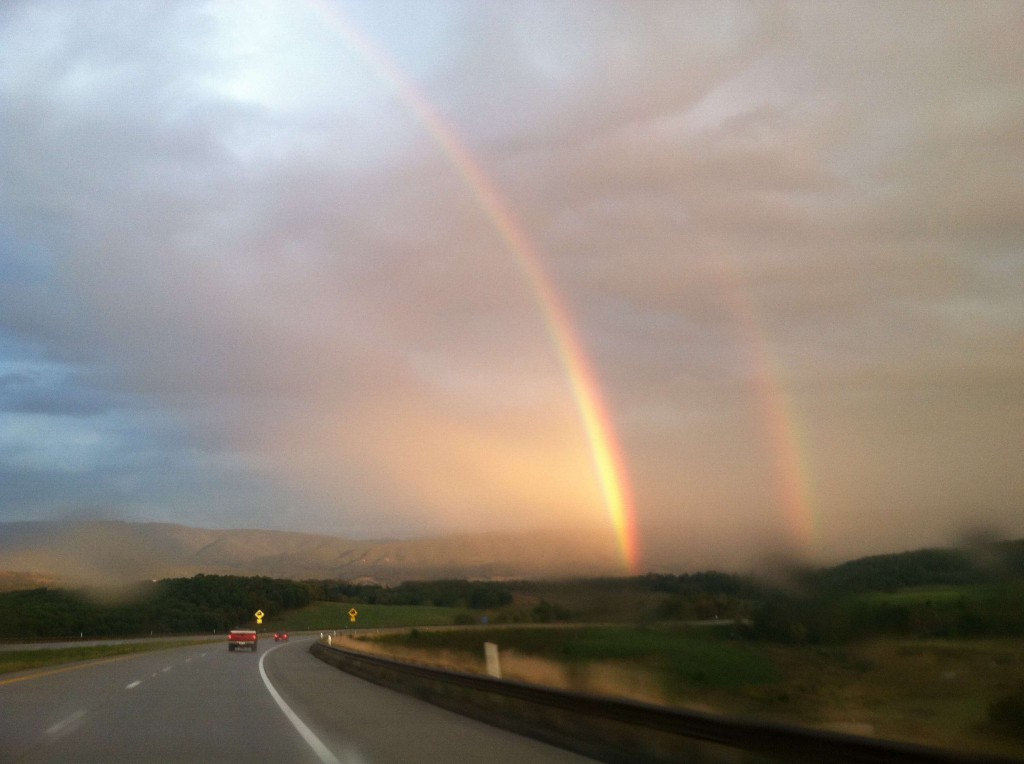
Happiest picture ever.
October 13, 2012
Baltimore, MD
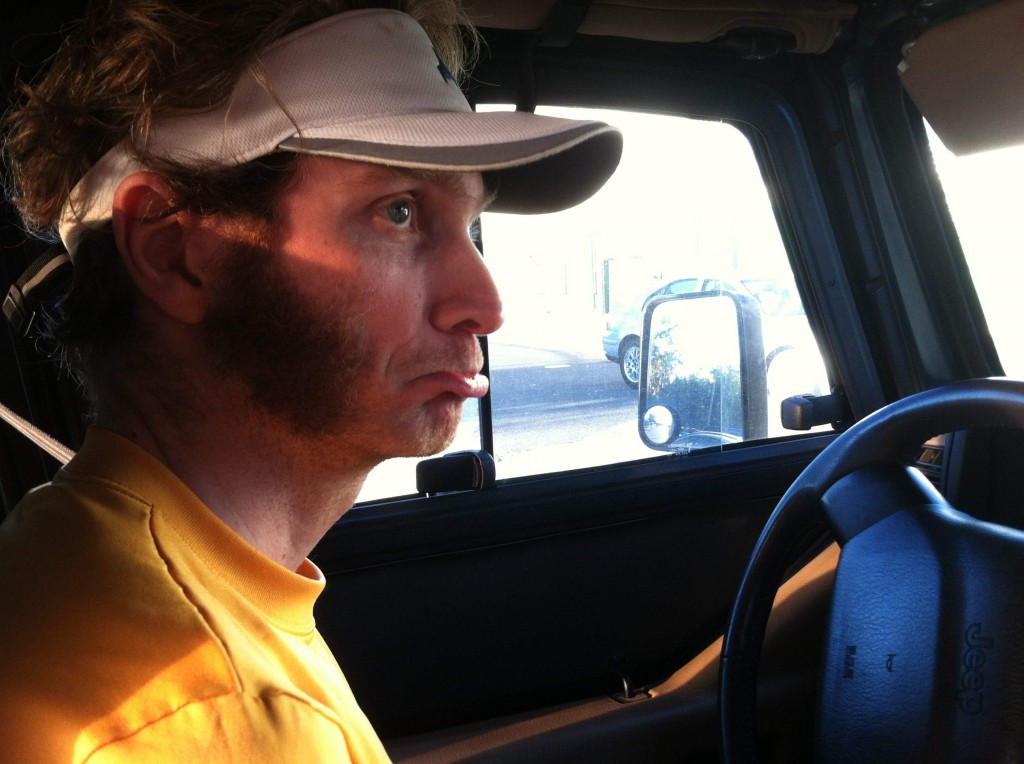
I had decided to run the Baltimore Marathon several months ago when I was riding a train to Baltimore to meet with some colleagues at Johns Hopkins University School of Public Health with whom I had been collaborating on a study of HIV community transmission dynamics. Aaron and I had become obsessed with HBO’s The Wire series, set in Baltimore, and when I realized that there was a big purse for Maryland residents, I shot the elite athlete coordinator an email to find out if I could qualify (a) as an elite and (b) as a Maryland resident (I work in Maryland, my parents live in Maryland, I consider myself a Marylander through and through). Given the affirmative by the RD, I decided to make Baltimore my fall marathon.
A week before the Baltimore Marathon I was confident I was going to PR, finally breaking that 2:55 I’d run three times. I’d been running really well all fall, with wins at the Women’s Half, the Dam Half, and even setting a 5k PR the week before the marathon in 17:34 at Ellen’s Run. I was even running up hills comfortably.
But when I WUSsed on Tuesday night my right hamstring was tweaked badly and my Wednesday run with Sean devolved into a skip, with every step hurting at a run. I took Thursday and Friday off and was feeling better, but I knew that if I had any prayer of running the marathon on Saturday I was going to have to start slowly and deliberately, easing into the race and seeing how things went. But in the days leading up to the marathon I was realizing that I wasn’t really in the right frame of mind to pull off a great marathon. I run best when I’m in a cut-loose frame of mind, relaxed, and carefree about life, and I’ve been really angsty lately, for several reasons. I know that our savant Sarah Stanley claims that life is full of rocks and that’s why we run: to learn how to step over the rocks. But I kind of work in reverse: if I can get all those damn life rocks out of the way, my legs will do their little running thing just fine. But learning how to run the rocks doesn’t do jack for getting the bills paid and the viral evolutionary patterns inferred and the papers published. Right now the biggest stresser is that my adored PhD adviser, Eddie Holmes, just left Penn State for Sydney, Australia. Eddie is universally acknowledged and the world’s foremost expert on viral evolution, and he has been indispensable as an adviser and key collaborator of mine. Even after leaving Penn State for Washington I’ve continued to make 5-6 visits every year to Penn State to pick Eddie’s brain on the projects I’m working on and discuss methods and approaches. I always came away from those trips clear-headed, with issues resolved, and re-invigorated to dive into my work. Without him, the quality my research will inevitably suffer — the question is whether it just drops a notch or two or whether it will implode. On top of Eddie leaving, Penn State has always been second family to me, so not only have I lost Eddie, but my whole Penn State running family (see post on The Last Noontime Run). The second big stresser has been the Federal government’s uncertain funding situation and the horrible deadlock in Congress, which has left my division at NIH with tenuous funding for the future, which has not only precluded any chance of my visiting Eddie in Australia but leaves my entire future at the NIH in question and has prompted me to begrudgingly send our resumes for faculty jobs. Even though it’s just an application with no obligation, entertaining the idea of taking on a tenure-track position in biology makes me kind of start to hyper-ventilate. I love my life the way it is, with a generally healthy balance between work and running and life, and I’m kind of terrified of upsetting that balance. Especially if I’m going to have a family some day — I mean, seriously, I think that trying to balance tenure-track, running, and family would send me into a tailspin. But I know I tend to over-think these things and am aware that I just need to go with the flow.
On top of these two big stressers they’ve demolished the nature preserve across the street from my apartment and are building two McMansions on the site, requiring jackhammering beginning at 7am every morning. I explicitly selected my apartment on a quiet residential street of DC precisely because I’m very sensitive to outside noise and surroundings, and the endless jackhammering along is enough to drive me nutters. And there’s just been a lot of little stressers as well — it turns out HIV is way harder to analyze than influenza due to the nature of its evolution, and that project has driven me mad. Most of my research lately has been on influenza in pigs (see Pigland post) and the people I work with at USDA just hired a new postdoc who will mainly supplant me of my privileged position as their main analyst of their data. I was hoping the new postdoc guy would be really dumb, but he’s actually really sharp. So I’ve lost my key data source, my most important research collaborator, my extended Penn State family, and financial security at my present job (not that they would fire me, just that we might not have funds for me to travel and have the resources to do interesting things). And my apartment has turned from a haven of peace to a place of blasting noise and diesel fumes. If Aaron weren’t around to zen me down on a daily basis, I would definitely have lost my little mind by now.

Anyway, back to the race. So Aaron and I woke up at 5:15am to make sure we got to the marathon with plenty of time to run an easy mile or so to loosen up our injuries — my hamstring and his Achilles — which would not take kindly to jumping into a quick pace in 40-degree temperatures. We were making perfect time, and arrived at the exit for Camden Yards at 7:15, plenty of time to park and get a little jog in before the 8am gun time. But the exit was backed up all the way onto the highway, and it took us an hour to get to the parking lots, which were all filled so we had to find street parking. It was kind of out of a Groucho Marx film, with all these cars circling around crazily looking for parking spots. The kicker was when we got stuck at the train tracks to let a long train pass through.
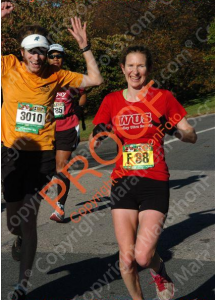
At that point we looked at the clock, looked at each other, and decided that this would just have to be a marathon fun run. I’d have to kiss that Maryland resident purse goodbye. ($800 for first, $500 for 2nd, $300 for 3rd). A few times Aaron tried to get me to jump out of the car and dash for the line, but (a) I didn’t know where the race start was and we were still miles away, (b) I didn’t want to abandon Aaron, and (c) the worst thing I could imagine for my hamstring was a full-on sprint to the start. How Raven Stadium, which regularly handles crowds of 40,000+ people and after so many years of holding this race, was completely overwhelmed by the marathon crowds remains a mystery.
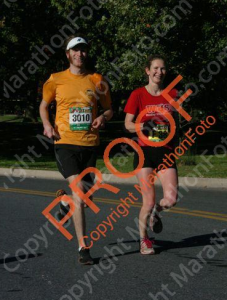
By the time we got to the starting line it was 35 minutes after gun time and the crew was already disassembling the chip mat. So we wouldn’t get a chip time, but we trotted on through the empty streets for what would become a long glorified training run. Those opening miles were wonderfully peaceful and quiet, and there was a certain thrill to Aaron and I running through what already seemed like a marathon ghost town. With no one else on the course, Aaron and I were heaped with attention from the remaining spectators and the bored traffic cops, whom we got to joke around with. Of course, nothing could top miles 4-5 through the Maryland Zoo, where zookeepers lined the course with a variety of avian friends — a raven, an Eastern screech owl, a kookaburra, and a PENGUIN! Aaron and I were glad we’d forgotten to carry our camera because we would have been delayed 20 minutes just taking pictures with the penguin.
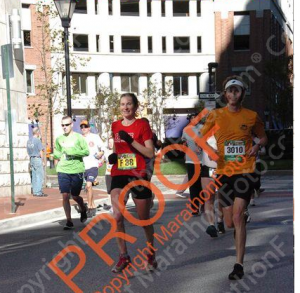 Around mile 7 we caught the marathon masses and had to start what would become a long day of weaving through the crowds. The course was really enjoyable: in addition to the highlight run through the zoo, there was a nice loop around Lake Montebello, lots of cool neighborhoods, a pass by the Inner Harbor, and a fabulous finish at Camden Yards. But my hamstring was bothering me a lot, and I began to realize that missing the start may have been for the best. I really had to keep my stride short and couldn’t fully extend, especially down the hills, and every stride hurt. And all the weaving and dodging made my perennially injured left IT band flare up, so suddenly I was limping on both sides. Aaron’s left Achilles started to really hurt from all the start-and-stop and lateral motion from the crowds, so he couldn’t push off with that foot, and we had to slow down the last miles. But the fact that Aaron and I enjoyed ourselves despite all the weaving (which got really bad when the half marathoners merged with us around mile 17) and pretty painful injuries is a testament to how sweet the course and day were.
Around mile 7 we caught the marathon masses and had to start what would become a long day of weaving through the crowds. The course was really enjoyable: in addition to the highlight run through the zoo, there was a nice loop around Lake Montebello, lots of cool neighborhoods, a pass by the Inner Harbor, and a fabulous finish at Camden Yards. But my hamstring was bothering me a lot, and I began to realize that missing the start may have been for the best. I really had to keep my stride short and couldn’t fully extend, especially down the hills, and every stride hurt. And all the weaving and dodging made my perennially injured left IT band flare up, so suddenly I was limping on both sides. Aaron’s left Achilles started to really hurt from all the start-and-stop and lateral motion from the crowds, so he couldn’t push off with that foot, and we had to slow down the last miles. But the fact that Aaron and I enjoyed ourselves despite all the weaving (which got really bad when the half marathoners merged with us around mile 17) and pretty painful injuries is a testament to how sweet the course and day were.
Aaron and I hightailed it out of there after finishing — we were fed up with being swarmed with crowds and just wanted some air. We had a victory lunch at Wegman’s in Columbia, MD, where folks were treated to the scene of a sore marathoner with a killer IT trying to make her version of a slow-motion hobbling mad dash for the Restroom that was up a flight of stairs and all the way in the back (I forgot to bring my magic papaya and had some bad stomach problems).
To pour a little acid on the wound, the top female Maryland resident finished in 3:06. I could have won $800! (Even with all the weaving (several times I had to stop dead because there was no where to do), the poop I took at mile 22 (and beer at mile 23) our fun run came in at 3:10). That would have bought me and Aaron a lot of ice cream. But can’t complain, it was overall a well-organized race — with Under Armor as the sponsor the race shirts were the best, and even the finisher medals had cute Maryland crabbies on them. And the elite coordinator Clay Shaw told us if we come back next year he will hook us up with a room.
Ellen’s Run 5k
Candy Cane City, Chevy Chase, MD
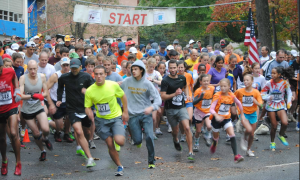
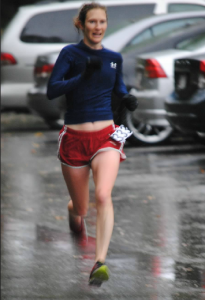
The race day forecast was for a 30 degree temperature drop and hard rain, and my mom and I agreed that we’d play it by ear at Ellen’s Run this year — as much as we love the race and its cause there was no sense getting hypothermia the week before the Baltimore Marathon. Aaron and I were somewhat disappointed when the weather was clear when we woke up race morning, meaning we would have to trudge out of bed. But once we picked up my mom and arrived at the race start in Candy Cane City, I at least was very glad to be there. Ellen’s Run 5k is one of my all-time favorites, a trip down memory lane. The race is held in honor of Ellen Vala Schneider, the mother of a Bethesda-Chevy Chase (B-CC) High School student, who struggled with depression and committed suicide in 2006. The entire BCC community comes out in droves for the race, including the BCC girls and boys cross country teams. I ran for B-CC back when I was in high school, class of 1999, and it’s fun to romp around with the high school kids. For me it’s the closest thing to a BCC homecoming — I always see Mr Mathis, my freshman year history teacher, and Pam Havell, my old soccer coach. Surrounded by gawky teenagers, for a moment I time-warp back to high school. The course also loops around my beloved Candy Cane City and Meadowbrook Stables, where I rode ponies, went bird-watching with my brother, and played tennis with my dad. And most memorably where we had our annual Thanksgiving day football bloodbaths. As I recall, the older the dude, the harder he tackled.
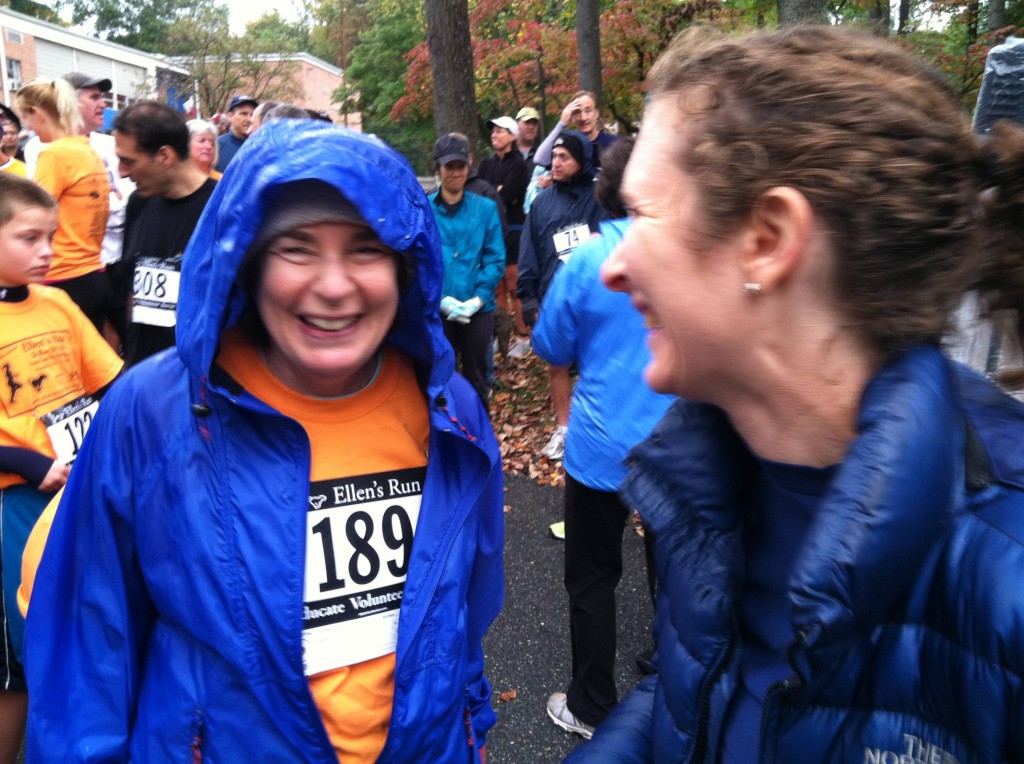
I’ve won Ellen’s Run every year I’ve run it — 2008, 2009, and now 2012. It’s a super-fast course, looping around Beach Drive, Candy Cane City, and Meadowbrook Lane past the horse stables. I ran it this year in 17:34, finishing 5th overall. I have to say, those high school boys are not so used to racing fast women. Lotta testosterone going around. I’m always amused/slightly irked by the boys who kill themselves not to get passed by me and then finish a minute or more behind. After I finish, I loop around to join my mom for her second half of the race, and of course her glorious windmill finish.
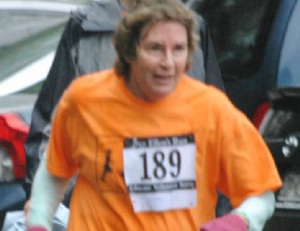
It’s heartening to know that even in my old age I can still give those high school boys a run for their money. But seeing those gaggles of B-CC girls together, arms around each other, laughing, I’m reminded of what I felt as a high school runner who, despite being the fastest one on the course always felt like an outsider, and enviously looked in on my friends who ran for the large cross country teams like Walter Johnson and Richard Montgomery, full of fast girls who competed together for the top spots. Today the BCC girls cross country team has 40 girls, is defending state and county champions — when I ran we had bedraggled team of 5 girls (one who walked) that celebrated if we didn’t finish dead last [for a more complete rendering of my high school running experience see the Back Pages post].
When we ran the donut run around this time last year, some of you recall the piggy paraphernalia I brought back from Minnesota — I hope Neal is still enjoying his boar juice bucket. I was reminded of wussies again during last week’s pig visit to USDA in Iowa. Des Moines had the best airport gift shop I’ve ever been to:
A t-shirt that read ‘In case of emergency please feed me bacon’ immediately invoked the spirit of Bobby Gill.
A t-shirt with the words ‘I like PIG butts and I cannot lie’ recalled Neal Gorman, when inebriated at Doug & Kerry’s wedding.
And another shirt with ‘You had me at “BACON”‘ — again, Bobby Gill.
As I arrived in Iowa, there were two major news stories about pigs hitting the newsstands. The ‘bacon scare’ story concerned the effect of the drought on the lowered production of corn and pig feed this summer and the prospects for pork product storages and higher prices this year. The second story was more disturbing: a 60-year old pig farmer had just been discovered devoured by his hogs. The pig experts in Iowa confirmed that hogs can weigh upwards of 500 pounds and are aggressive, inquisitive, voraciously hungry animals. While it was unlikely that the hogs would attack unprovoked, if the man fell or had a heart attack, the enormous hogs could certainly have taken advantage of him in a prone state. In a grisly story from 2007 a pig farmer serial killer from Canada murdered at least 25 prostitutes and female drug addicts and fed their remains to his pigs.
When Amy from the USDA’s Agricultural Research Service (ARS) asked me if I had any specific requests for my visit to their center in Ames, Iowa, I asked if I could tour a pig farm. The production process for swine in the United States is actually quite complex, with multiple production stages that involve different kinds of pens and facilities and transport of pigs, and I wanted to learn more about how the process might affect influenza virus transmission dynamics. But after discovering the vicious side of the little piggy, I was relieved when Amy informed me that I would have to settle for an indoor Pork Production 101 powerpoint presentation by the pig guru Butch Baker. I know some day I will bite the dust, but I’d rather it not involve being devoured by 500-pound hogs.
For those of you who still have your semen collection cups and pig insemination tubes from last year’s pig visit to Minneapolis, I can now answer some of your burning questions about pig production:
-Today, more than 90% of sows are bred via artificial insemination.
-Pigs can grow from 3 lbs to 300 lbs in 9 months, making them one of the most efficient animals for production of meat.
-China is the Pig King of the World, producing ~600 million pigs per year, compared with the US, a distant second place at ~115 million pigs per year.
-The number of US pig farms has reduced dramatically from over 1 million in the 1960s to less than 50,000 today, as the industry has greatly consolidated and a few major producers now strongly dominate the industry.
-The US swine industry estimates it lost ~$50 BILLION from the 2009 ‘swine flu’ virus, even though not a single US pig was infected with the virus at the time (humans have since introduced the virus into the US pig population). The biggest hits were exports (countries like China cut off US swine exports, even though no US pigs were infected) and to the drop in domestic pork consumption due to misinformed consumer fears. Such economic fallout has made the pig producers extremely wary of the media and very secretive about disease information among their swine herds, making my job of studying influenza virus dynamics among US swine populations exponentially more difficult.
-You all know how human influenza vaccines are regularly updated with the most currently circulating strains, as identified through a well-organized global WHO surveillance network (why you have to get your flu shot every year). To facilitate this process, vaccine manufacturers are not required by FDA to re-license their updated vaccine every year. In contrast, the USDA regulatory hurdles for updating the influenza vaccine used in swine are substantial, equivalent to licensing a new vaccine, and the swine influenza vaccine has not been updated in recent years despite the continued evolution of the influenza virus in swine and the vaccine’s limited efficacy. We all find it a bit twisted that the regulatory hurdles for a vaccine for pigs is so much more stringent than for humans. So instead of using the outdated commercial vaccines, pig farmers are increasingly resorting to unlicensed autogenous vaccines (up to 60% of vaccines now are autogenous), essentially the ‘snake oil’ of the swine vaccine world.
-Iowa is the corn capital of the world. Since corn is used as pig feed, the bulk of the swine industry is located in Iowa and neighboring Midwest states (hence all the bacon-themed shirts in the Des Moines airport gift shop). In the 1990s, newer swine production facilities were built in North Carolina and Oklahoma. However, since it’s cheaper to transport the piglets than the corn required to feed them (piggies eat a lot of corn to grow 300 lbs in 9 months!), many of these piglets are trucked to Iowa and other Midwestern states to be fattened up prior to slaughter. We’ve been studying how these long-distance trucking practices spread pathogens like influenza around the US and particularly into Iowa and the Midwest.
Rt 48 through West Virginia
September 30, 2011
I snapped a few photos of a full arc double rainbow we saw driving back to DC from Canaan Valley. Absolutely the most stunningly clear rainbow I’ve ever seen. I wish I had better photos than these I took with Aaron’s iPhone camera while driving in the Jeep.
ps – you NEED to see the youtube double rainbow dude

